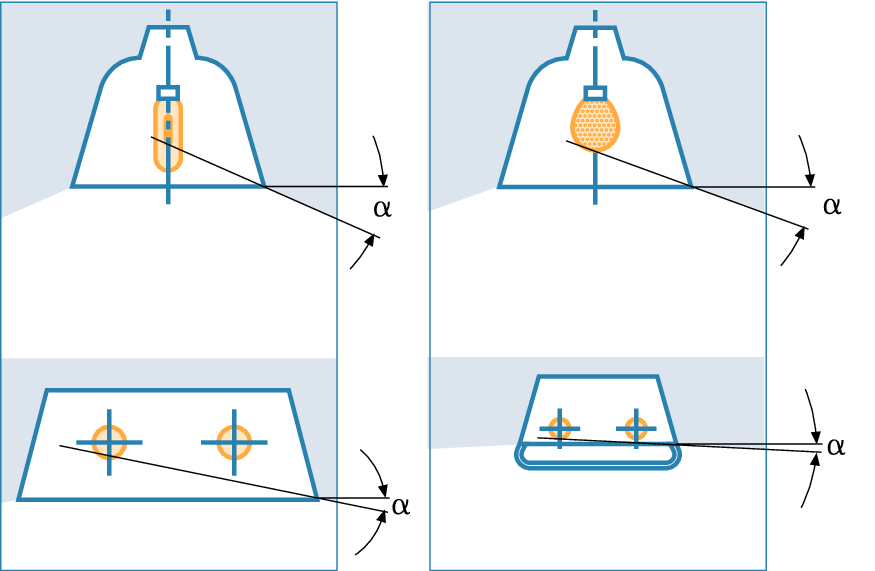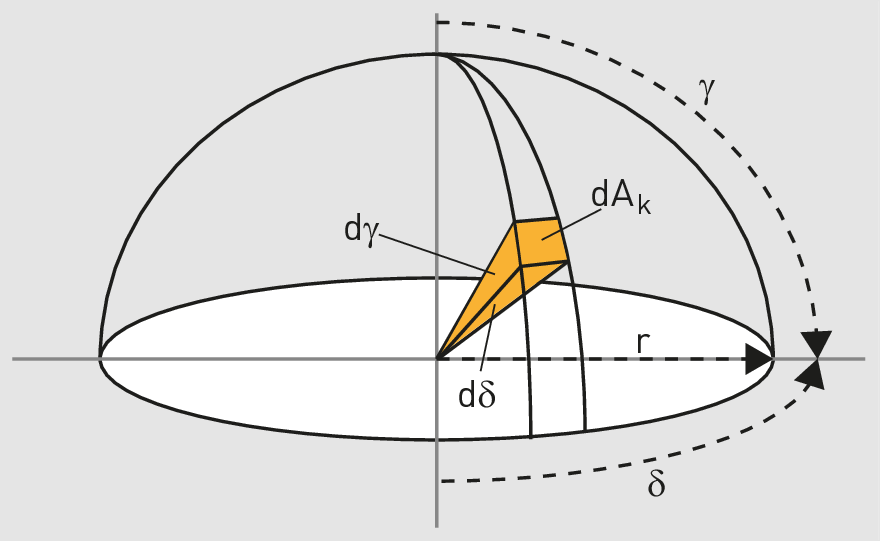(Esc) Arithmetic average of the vertical illuminance Ev incident at a point in the horizontal angle range between 0° and ± 90°. It is therefore the quotient of the luminous flux Φ incident on the lateral area of an upright half cylinder and the size of the lateral area A.
S

The direction of the semi-cylindrical illuminance, i.e. of the curved surface, must be specified.
Unit: lux (lx).
(Ehs) Semi-spherical illuminance. Luminous flux, in relation to the curved surface of a hemisphere which is situated on the plane to be rated.
Unit: lux (lx).
For lamps, there is a distinction between nominal service life, economic service life and average service life. The nominal service life was defined particularly for high-pressure discharge lamps with low switching frequencies. It denotes the time span upon which the expiration of 90% of all lamps remain ready for operation at a switching frequency of 12 hours with 11 hours ON and 1 hour OFF (abbreviation 12B10). The decrease in lamp luminous flux is not considered in this definition.
Economic service life (useful life) denotes the time span upon the expiration of which the luminous flux of all lamps in a lighting installation under standardised conditions due to lamp failure and decrease in luminous flux reaches a certain value. For fluorescent lamps, 80% of the initial value of the installation’s luminous flux is defined as useful life. For this, the defined switching frequency has three hours, with 165 minutes ON and 15 minutes OFF. The average service life is the (statistical) average of the service life of the lamps operated under standardised conditions, e.g. the time span upon the expiration of which 50% of all lamps have failed. The decrease in lamp luminous flux is not considered in this definition. This definition is used for incandescent lamps and tungsten halogen lamps (see also chapter "Service life of lamps").
For LED luminaires, a rated service life Lx is defined. It refers to a residual luminous flux still to be expected upon expiration of the time span, the value (expressed in percentage) in relation to the initial luminous flux (rated luminous flux) is expressed through the index x (e.g. L80 = 50,000 h, see also chapter "service life of LED luminaires").
The average vertical illuminance Ev on a cylinder surface yields the cylindrical illuminance Ez. The relation between cylindrical and horizontal illuminance Eh defines the shadow detail Ez/Eh at this point. In indoor spaces, its value at 1.2 m above the floor should be between 0.3 and 0.6. The shadow detail is also called modelling (see also chapter “modelling”).
Angle between the horizontal plane and the first line of sight at which the luminous parts of the lamps in the luminaire are directly visible (definition according to EN 12464-1, see also chapter "Shielding angle").

(Ω) The solid angle Ω is the quotient of the area Ak subtended by a cone from a sphere and the squared radius r of the sphere. The opening of the cone is determined by the meridian angle dδ and the latitudinal angle dγ.
In differential notation this is expressed as follows:


If the cone is a circular cone, the half of its opening angle α can be calculated using the formula cos α = 1–Ω/(2π).
Unit: steradian (sr)


Examples:
For Ω = 1 sr, α = 32, 77∘
For α = 90∘, meaning the half space, iΩ = 2 ⋅ π sr
For α = 180∘, meaning the full space, Ω = 4 ⋅ π sr
Light and lighting technology and electro technology standards are composed at international, European and national level. They partially concur, but can also vary significantly. In their respective area of application, they represent the “generally acknowledged state of the art”. Standard organisations are:
ISO International Organization for Standardization
IEC International Electrotechnical Commission
CIE Commission internationale de l’éclairage (international lighting commission) with a current number of 37 national committees.
CEN Comité Européen de Normalisation (European standards committee)
CENELEC European Committee for Electrotechnical Standardization
Currently, there are 31 national standardisation organisations working in CEN and CENELEC, among those are for example British Standards Institution BSI, Deutsches Institut für Normung e. V. DIN, Association française de normalisation AFNOR, Ente Nazionale Italiano di Unificazione UNI, Nederlands Normalisatie-instituut NEN, Österreichisches Normungsinstitut ON, Schweizerische Normen-Vereinigung SNV (see also chapter ).
The immediate surrounding area according to EN 12464-1 is adjacent to the visual task area and encompasses the areas in the field of vision which surround the visual task area at a width of at least 0.5 m. Adjacent to this is the background area, for which EN 12464-1 also contains photometric requirements, see also background lighting.
According to the German ASR A3.4, the surrounding area does not merely refer to the immediate surrounding area, but to a spatial area which is directly adjacent to the area of one or several workstations or is limited by the walls of the room or circulation areas.